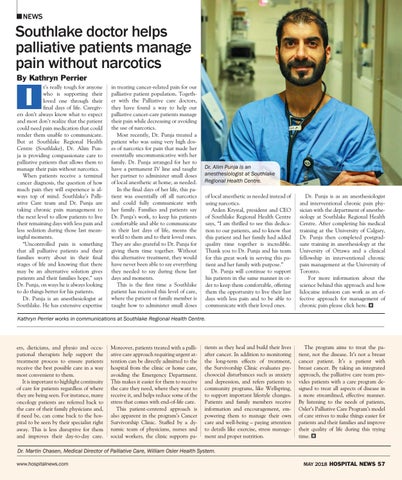NEWS
Southlake doctor helps palliative patients manage pain without narcotics By Kathryn Perrier t’s really tough for anyone who is supporting their loved one through their final days of life. Caregivers don’t always know what to expect and most don’t realize that the patient could need pain medication that could render them unable to communicate. But at Southlake Regional Health Centre (Southlake), Dr. Alim Punja is providing compassionate care to palliative patients that allows them to manage their pain without narcotics. When patients receive a terminal cancer diagnosis, the question of how much pain they will experience is always top of mind. Southlake’s Palliative Care team and Dr. Punja are taking chronic pain management to the next level to allow patients to live their remaining days with less pain and less sedation during those last meaningful moments. “Uncontrolled pain is something that all palliative patients and their families worry about in their final stages of life and knowing that there may be an alternative solution gives patients and their families hope,” says Dr. Punja, on ways he is always looking to do things better for his patients. Dr. Punja is an anesthesiologist at Southlake. He has extensive expertise
I
in treating cancer-related pain for our palliative patient population. Together with the Palliative care doctors, they have found a way to help our palliative cancer-care patients manage their pain while decreasing or avoiding the use of narcotics. Most recently, Dr. Punja treated a patient who was using very high doses of narcotics for pain that made her essentially uncommunicative with her family. Dr. Punja arranged for her to have a permanent IV line and taught her partner to administer small doses of local anesthetic at home, as needed. In the final days of her life, this patient was essentially off all narcotics and could fully communicate with her family. Families and patients say Dr. Punja’s work, to keep his patients comfortable and able to communicate in their last days of life, means the world to them and to their loved ones. They are also grateful to Dr. Punja for giving them time together. Without this alternative treatment, they would have never been able to say everything they needed to say during those last days and moments. This is the first time a Southlake patient has received this level of care, where the patient or family member is taught how to administer small doses
Dr. Alim Punja is an anesthesiologist at Southlake Regional Health Centre. of local anesthetic as needed instead of using narcotics. Arden Krystal, president and CEO of Southlake Regional Health Centre says, “I am thrilled to see this dedication to our patients, and to know that this patient and her family had added quality time together is incredible. Thank you to Dr. Punja and his team for this great work in serving this patient and her family with purpose.” Dr. Punja will continue to support his patients in the same manner in order to keep them comfortable, offering them the opportunity to live their last days with less pain and to be able to communicate with their loved ones.
Dr. Punja is as an anesthesiologist and interventional chronic pain physician with the department of anesthesiology at Southlake Regional Health Centre. After completing his medical training at the University of Calgary, Dr. Punja then completed postgraduate training in anesthesiology at the University of Ottawa and a clinical fellowship in interventional chronic pain management at the University of Toronto. For more information about the science behind this approach and how lidocaine infusion can work as an effective approach for management of H chronic pain please click here. ■
Kathryn Perrier works in communications at Southlake Regional Health Centre.
ers, dieticians, and physio and occupational therapists help support the treatment process to ensure patients receive the best possible care in a way most convenient to them. It is important to highlight continuity of care for patients regardless of where they are being seen. For instance, many oncology patients are referred back to the care of their family physicians and, if need be, can come back to the hospital to be seen by their specialist right away. This is less disruptive for them and improves their day-to-day care.
Moreover, patients treated with a palliative care approach requiring urgent attention can be directly admitted to the hospital from the clinic or home care, avoiding the Emergency Department. This makes it easier for them to receive the care they need, where they want to receive it, and helps reduce some of the stress that comes with end-of-life care. This patient-centered approach is also apparent in the program’s Cancer Survivorship Clinic. Staffed by a dynamic team of physicians, nurses and social workers, the clinic supports pa-
tients as they heal and build their lives after cancer. In addition to monitoring the long-term effects of treatment, the Survivorship Clinic evaluates psychosocial disturbances such as anxiety and depression, and refers patients to community programs, like Wellspring, to support important lifestyle changes. Patients and family members receive information and encouragement, empowering them to manage their own care and well-being – paying attention to details like exercise, stress management and proper nutrition.
The program aims to treat the patient, not the disease. It’s not a breast cancer patient. It’s a patient with breast cancer. By taking an integrated approach, the palliative care team provides patients with a care program designed to treat all aspects of disease in a more streamlined, effective manner. By listening to the needs of patients, Osler’s Palliative Care Program’s model of care strives to make things easier for patients and their families and improve their quality of life during this trying H time. ■
Dr. Martin Chasen, Medical Director of Palliative Care, William Osler Health System. www.hospitalnews.com
MAY 2018 HOSPITAL NEWS 57
